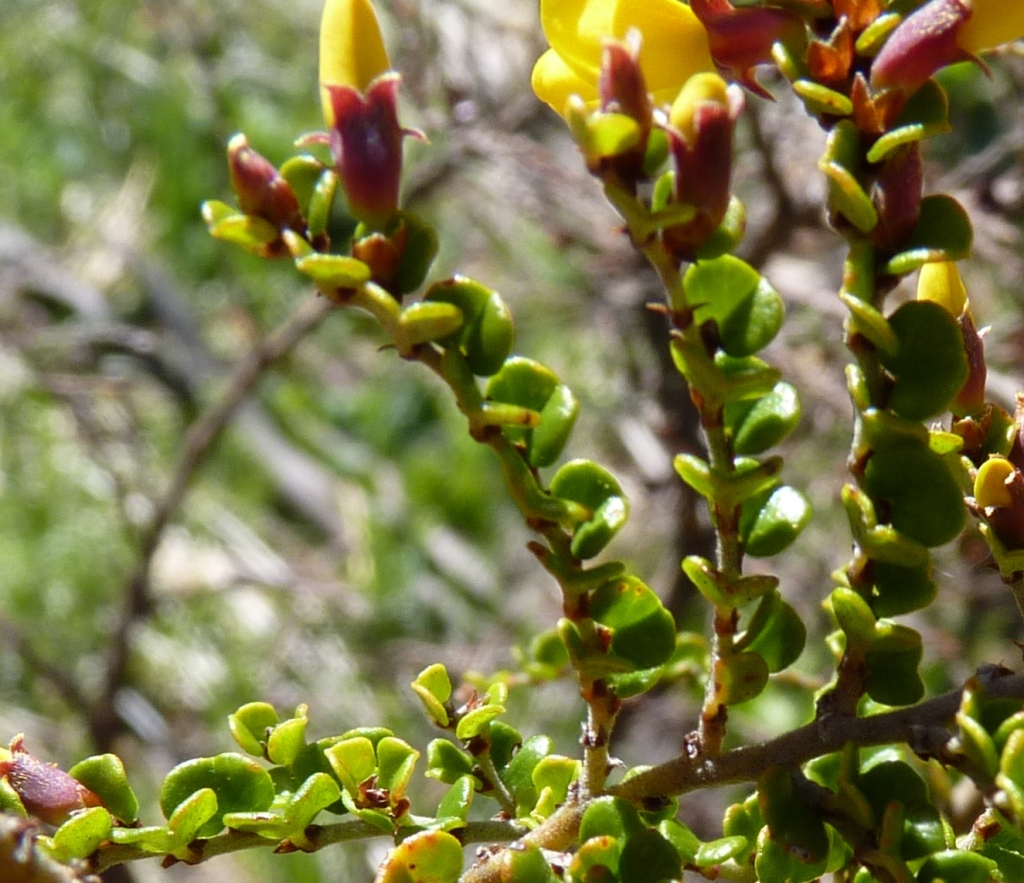Bossiaea foliosa
A.Cunn. Leafy BossiaeaErect shrub to c. 1.5 m high; branches terete, suberect to spreading, with a moderately dense cover of straight or wavy hairs. Leaves alternate, unifoliate, broadly ovate, orbicular, or transversely oblong, 1.5–3 mm long, 1.5–3.5 mm wide; base truncate to cordate; apex broadly rounded or truncate; upper surface minutely tuberculate; lower surface distinctly concave, minutely white-dotted, with scattered hairs; margin recurved, sometimes revolute in distal half; stipules triangular to narrow-triangular, 0.4–1(–1.5) mm long, glabrescent, exceeding petiole, semi-persistent. Flowers solitary, 5–7 mm long; pedicle 0.5–2.5 mm long, glabrous or with scattered hairs; bracts crowded, broad-ovate to almost circular, c. 0.5 mm long; bracteoles inserted at base of calyx, broad-ovate, 0.5–1 mm long, glabrous or sparsely hairy, persistent; calyx 2–3.5 mm long, pubescent, lobes acute, c. equal to tube, upper lobes broader than lower; corolla uniformly bright yellow, petals ± equal in length; ovary stipitate, 2-ovulate, densely pubescent. Pods c. orbicular, 5–8 mm long, rusty-pubescent; stipe c. 1.5 mm long. Flowers Oct.–Dec.
VRiv, CVU, NIS, EGL, EGU, HSF, HNF, MonT, HFE, VAlp. Also NSW, ACT. Common component of alpine and subalpine communities in north-east and east Victoria. Restricted in Victoria to ranges near the border with New South Wales (e.g. Cobberas, Dartmouth area, Bendoc, Coopracambra National Park) at altitudes of 800–1200 m, commonly on stony soils in open forest and woodland.
Previously this name was widely applied to small-leaved plants with shortly stalked, entirely yellow flowers growing in alpine and subalpine areas. This is now regarded as a species complex that includes B. alpina, B. sericea, and B. distichoclada. These four species are distinguished by a combination of characters including leaf shape, indumentum and colour, bracteole and stipule length, and calyx indumentum. Bossiaea foliosa is characterised by its convex leaves that appear somewhat ovate in shape due to the strongly recurved margins near the apex, are tuberculate on the upper surface and white-dotted below. It has relatively short stipules and bracteoles, calyces are hairy whereas the pedicles are glabrous. Bossiaea foliosa is widespread throughout alpine and subalpine regions of New South Wales, but apparently does not extend beyond Mitta Mitta or the Cobberas in north eastern Victoria.
Ross, J.H. (1996). Bossiaea. In: Walsh, N.G.; Entwisle, T.J., Flora of Victoria Vol. 3, Dicotyledons Winteraceae to Myrtaceae, pp. 808–815. Inkata Press, Melbourne.
 Spinning
Spinning
